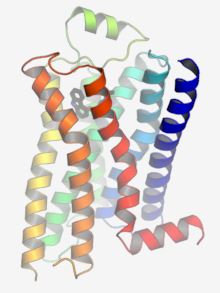Introduction of GPR139
Belonging to the class A orphan G-protein-coupled receptor (GPCR) family, GPR139 is encoded by the GPR139 gene. G protein-coupled receptors (GPCRs) constitute the largest family of cell surface proteins and they are involved in a broad spectrum of neuronal control about the vision, neurotransmission, immune responses, and metabolism. With two transcript variants, GPR139 was identified from bioinformatics analysis of the human genome. The high conservation between different species reminds that GPR139 has an important role in physiological processes.
| Basic Information of GPR139 | |
| Protein Name | G-protein coupled receptor 139 |
| Gene Name | GPR139 |
| Aliases | GPRG1, PGR3 |
| Organism | Homo sapiens (Human) |
| UniProt ID | Q6DWJ6 |
| Transmembrane Times | 7 |
| Length (aa) | 353 |
| Sequence | MEHTHAHLAANSSLSWWSPGSACGLGFVPVVYYSLLLCLGLPANILTVIILSQLVARRQKSSYNYLLALAAADILVLFFIVFVDFLLEDFILNMQMPQVPDKIIEVLEFSSIHTSIWITVPLTIDRYIAVCHPLKYHTVSYPARTRKVIVSVYITCFLTSIPYYWWPNIWTEDYISTSVHHVLIWIHCFTVYLVPCSIFFILNSIIVYKLRRKSNFRLRGYSTGKTTAILFTITSIFATLWAPRIIMILYHLYGAPIQNRWLVHIMSDIANMLALLNTAINFFLYCFISKRFRTMAAATLKAFFKCQKQPVQFYTNHNFSITSSPWISPANSHCIKMLVYQYDKNGKPIKVSP |
Function of GPR139 Membrane Protein
GPR139 is predominantly expressed in different brain regions, and the distribution areas indicate the possible function of GPR139. Expressed in the striatum suggest that GPR139 may play a role in locomotor activity. Furthermore, the abundance of GPR139 in hypothalamus and habenula reveals a role in the regulation of food consumption and energy expenditure. GPR139 is thus a potential target for the treatment of Parkinson’s disease, obesity, eating disorders, and diabetes. As the surrogate agonist, structurally related benzohydrazide, glycine benzamide, and benzotriazine have been widely used. Three endogenous melanocortin 4 receptor agonists, including adrenocorticotropic hormone (ACTH) and α- and β-melanocyte can active GPR139 in a low micromolar range. The activation of GPR139 is also performed by the essential amino acids L-tryptophan (L-Trp) and L-phenylalanine (L-Phe) in the hundred-micromolar range, and the activation exhibits concentration-dependence. In addition, GPR139 agonists were demonstrated to protect dopaminergic neuronal degeneration against 1-methyl-4-phenylpyridinium (MPPC).
 Fig.1 Structure of GPR139 membrane protein.
Fig.1 Structure of GPR139 membrane protein.
Application of GPR139 Membrane Protein in Literature
This article suggests that when co-transfected with GPR139 and melanocortin (MC) receptors (MC3R, MC4R, and MC5R), three MC peptides: adrenocorticotropic hormone (ACTH), α- and β-melanocyte can stimulate hormones (α-MSH and β-MSH) calcium mobilization in cells. They unravel an in vitro interaction between GPR139 and the MCRs.
The authors provide a mutagenesis-guided model of GPR139 binding site to optimize structure-based ligand. Aide by mutagenesis, ligand docking, and free energy calculations, the authors testify that surrogate agonists 1a and 7c, and the endogenous amino acids L-tryptophan (L-Trp) and L-phenylalanine (L-Phe) share a common binding site.
Selecting from a pharmacophore model, the authors assay 158 new analogs of GPR139 agonists and identify 12 new GPR139 agonists, containing previously untested bioisosteres. Furthermore, they construct a new pharmacophore model to identify and optimize the GPR139 ligand.
This article firstly reveals that adrenocorticotropic hormone (ACTH) and α- and β-melanocyte stimulating hormone (α-MSH and β-MSH) can activate GPR139 in the low micromolar range. As melanocortin 4 receptors, three peptides have conserved core motif HFRW. Moreover, α-MSH consisting of nine or ten N-terminal residues activated GPR139 in the submicromolar range.
This article highlights that GPR139 agonists can protect primary mesencephalic DA neurons against 1-methyl-4- phenylpyridinium (MPPC)-mediated degeneration in vitro, however, the neurotoxin rotenone and 6-hydroxydopamine (6-OHDA) cannot be prevented by GPR139. And the protection shows concentration-dependence and could be blocked by GPR139 antagonist.
GPR139 Preparation Options
To obtain the soluble and functional target protein, the versatile Magic™ membrane protein production platform in Creative Biolabs enables many flexible options, from which you can always find a better match for your particular project. Aided by our versatile Magic™ anti-membrane protein antibody discovery platform, we also provide customized anti-GPR139 antibody development services.
Creative Biolabs has abundant experience in the preparation of membrane protein, an acknowledged technical problem in the protein engineering. The prospective research, strong technical force and highly cooperative group have been recognized by our customers. Numerous challenging projects choose us based on our excellent service. Please feel free to contact us for more information.
All listed services and products are For Research Use Only. Do Not use in any diagnostic or therapeutic applications.